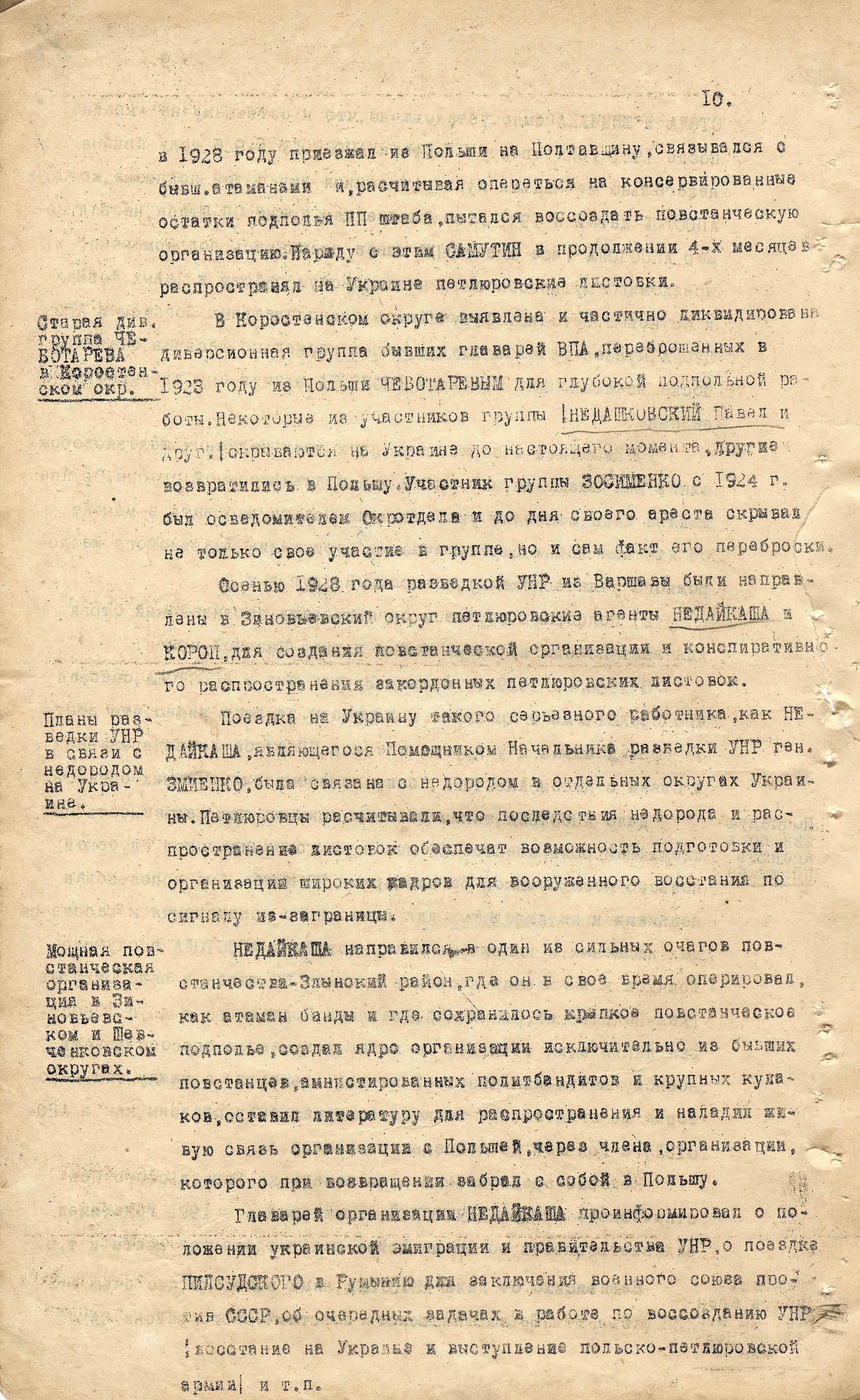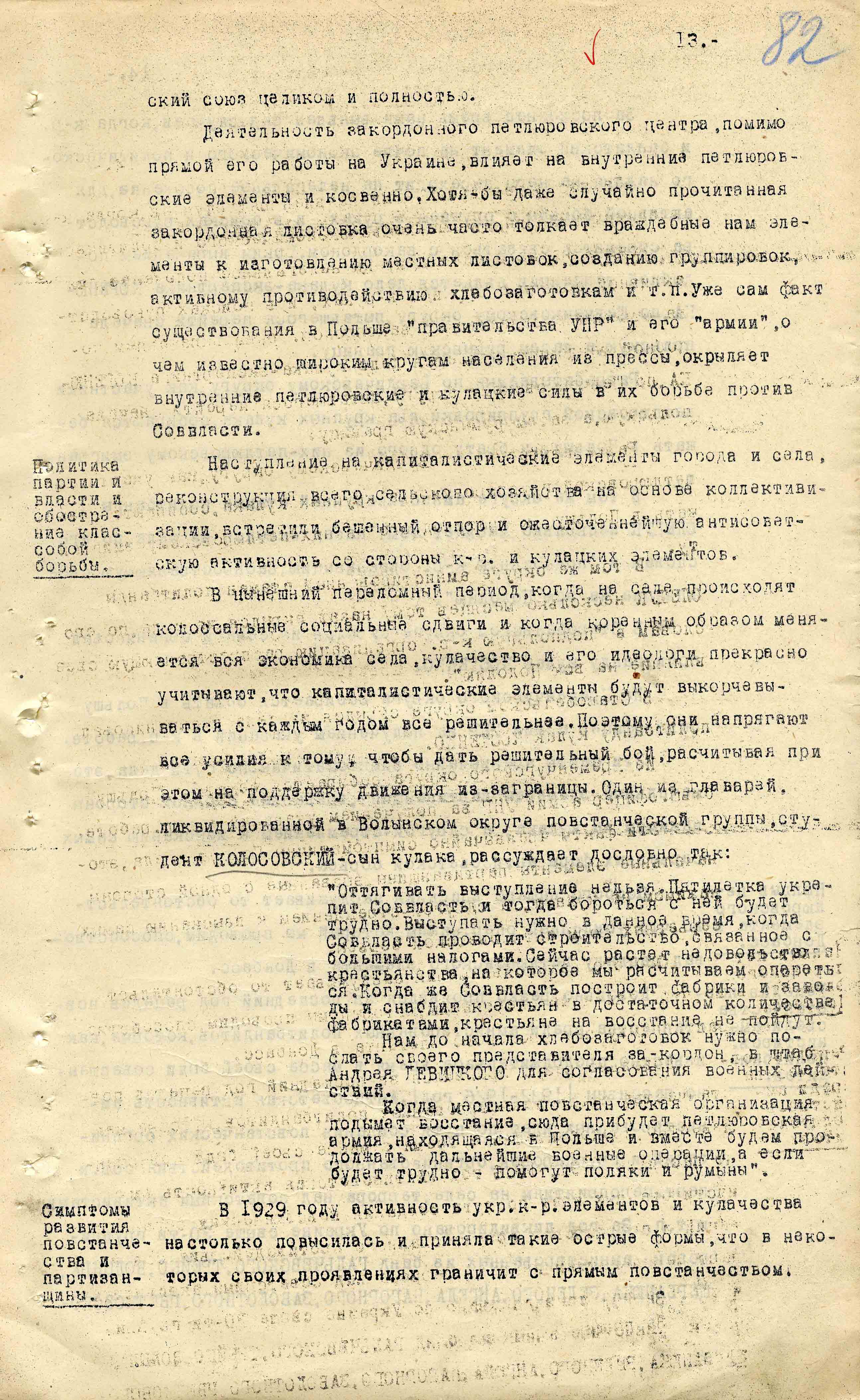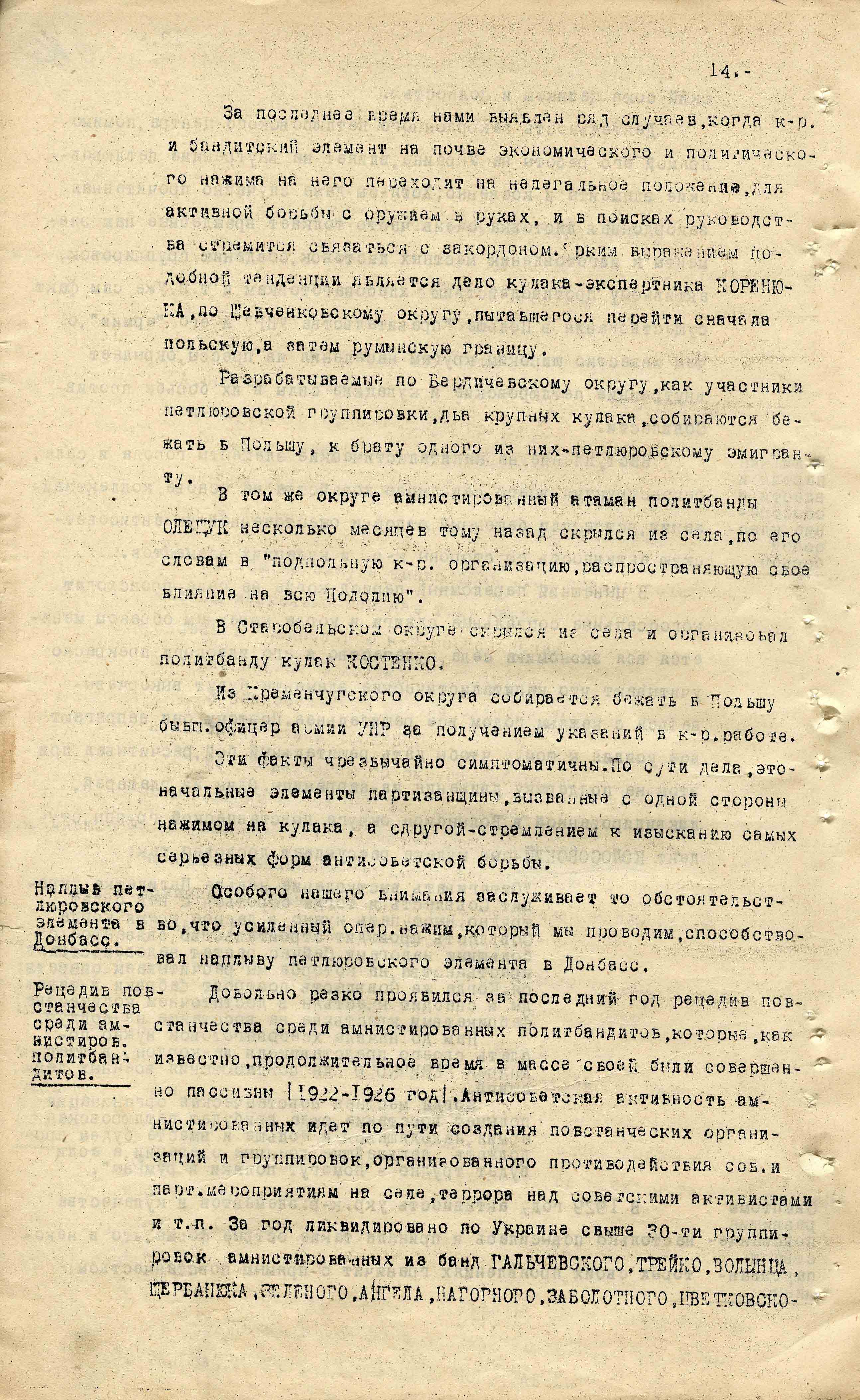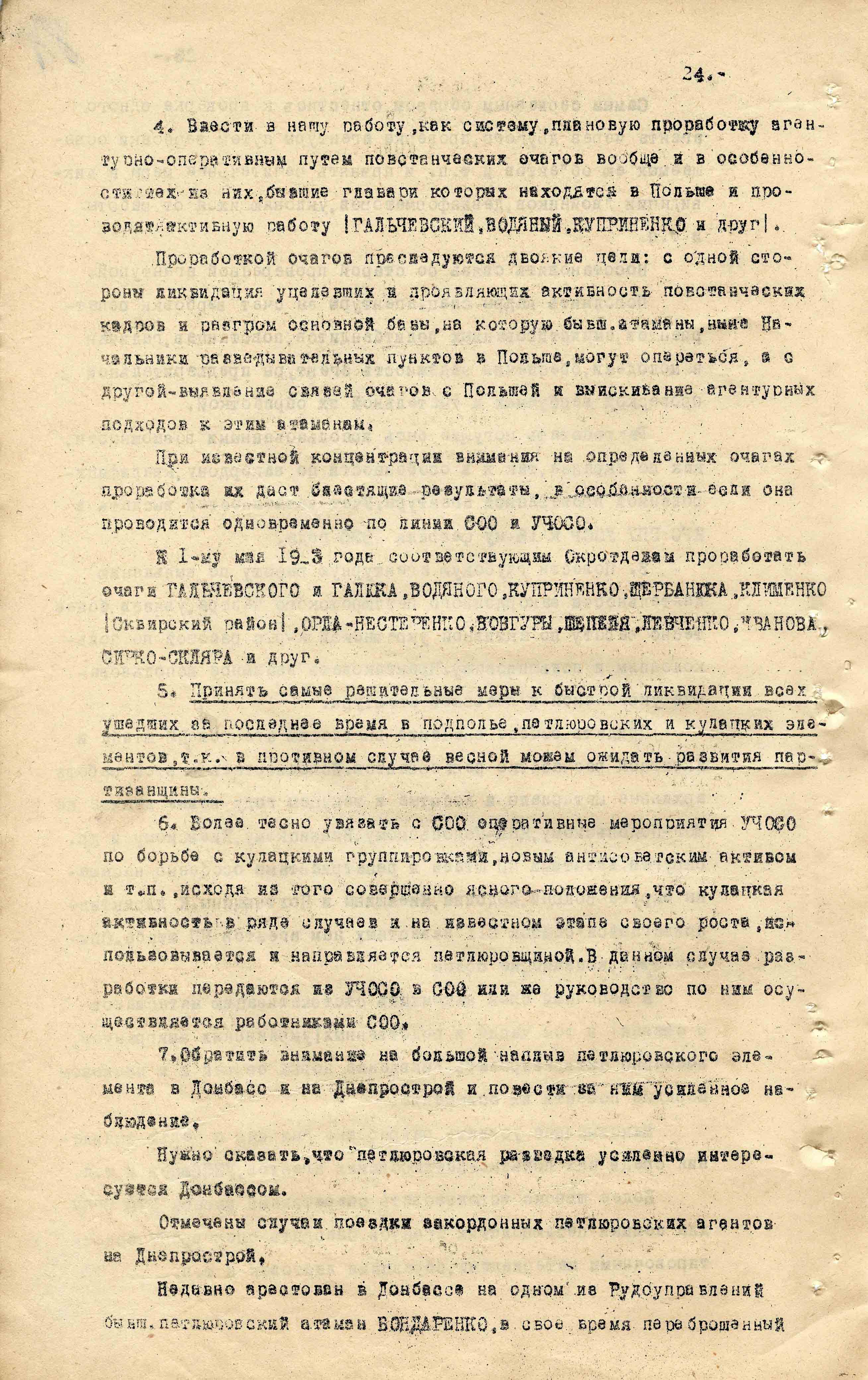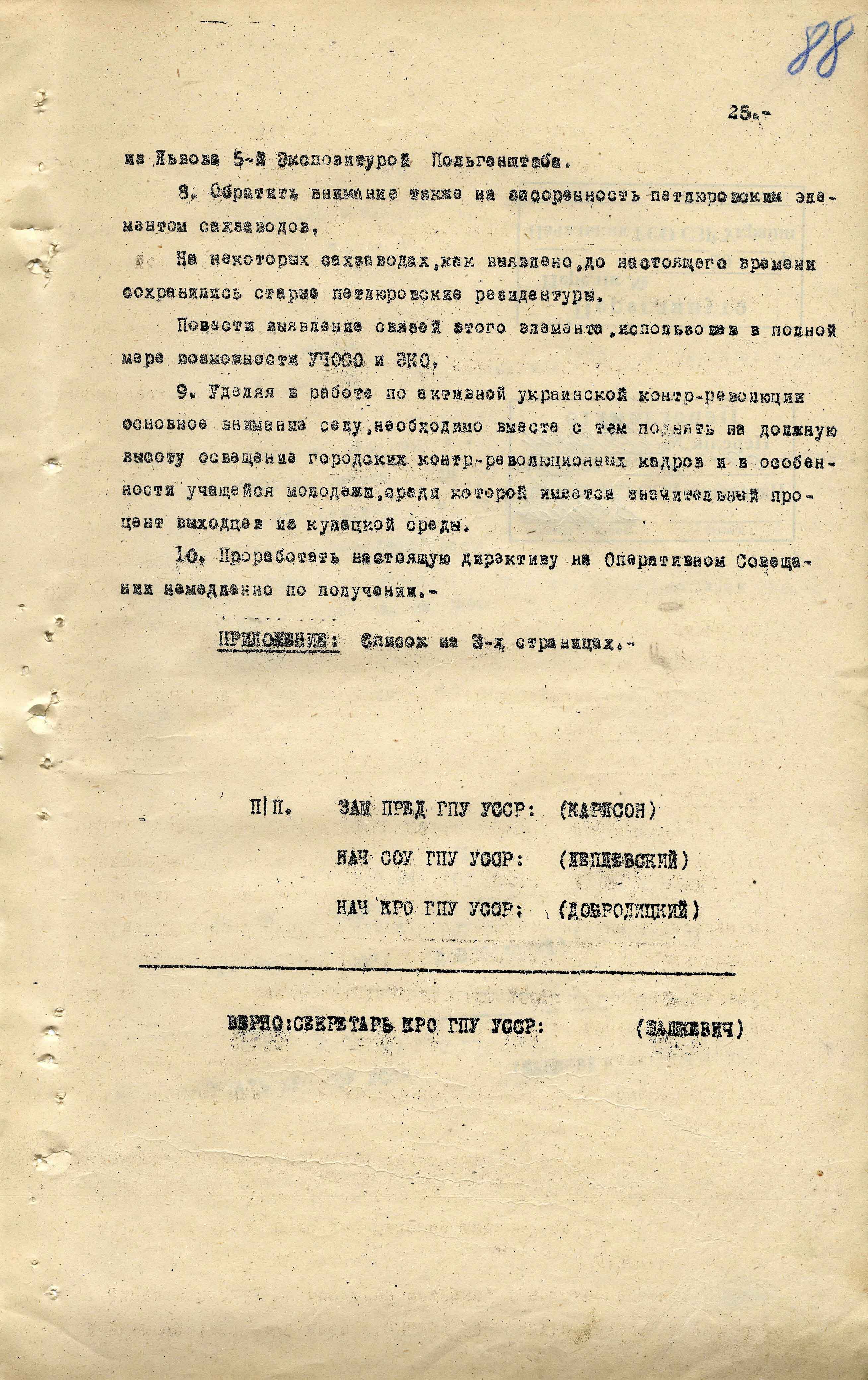Harbingers of the Holodomor. The Year 1929
11/23/2023
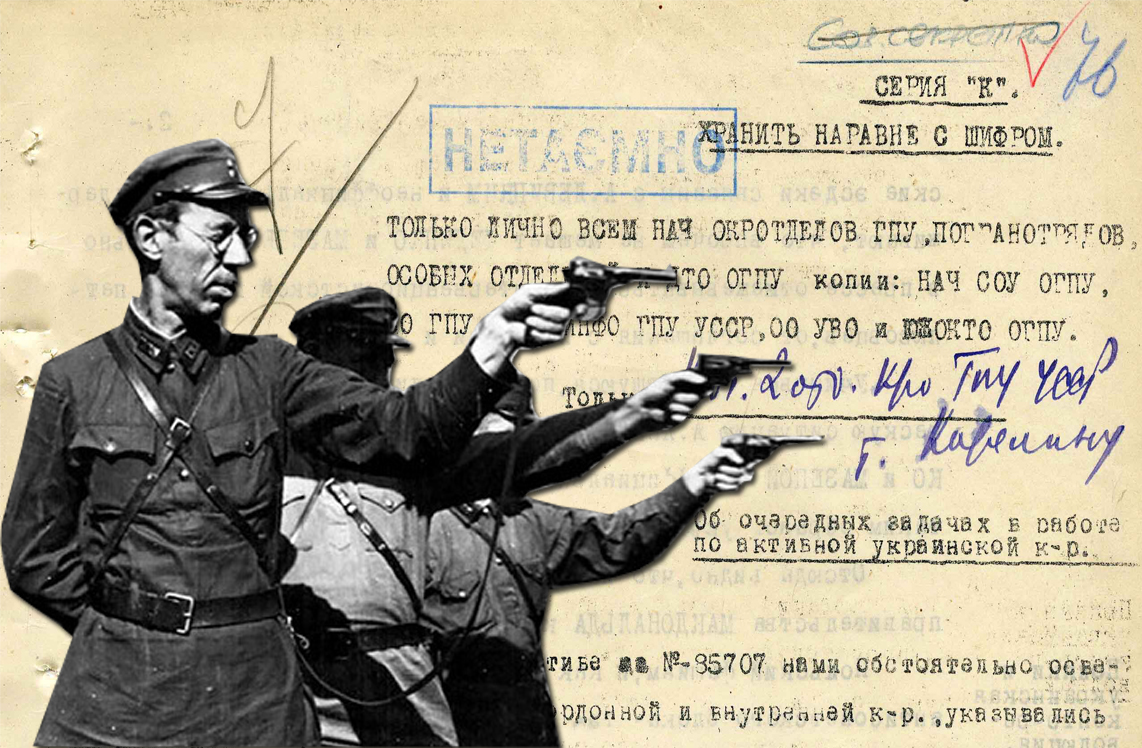
In the archives of the Intelligence, a document of the gpu of the ukrainian ssr, dated 1929, was found, entitled “On the next tasks in working with the active Ukrainian counter-revolution” and with a note at the top – “Keep on a par with the cipher”. Three years before the start of the large-scale famine in Ukraine, it traces how stalin's special services recorded “an invisible surge of anti-soviet activity in villages”, the revival of insurgent committees, infiltration of UPR intelligence officers from abroad into all regions to incite villagers to resistance. At the same time, the chekists themselves had been escalating the situation and portraying it as extremely threatening to the existence of the soviet government, in order to soon launch the flywheel of the repressive machine at full capacity and finally tame the Ukrainian freedom-loving spirit.
“Keep on a Par with the Cipher”
In addition to the fact that the document was marked “Top Secret”, the mark “Keep on a Par with the Cipher” made those to whom it was addressed feel involved in something extremely secretive. And it was addressed “only personally” to the heads of the secret operational directorate, secret, counterintelligence and several other departments of the central office, district departments and border detachments of the gpu of the ukrainian ssr.
On 25 pages, there was an analysis of the “counter-revolutionary tendencies” of the UPR government in exile and the operational situation in the ukrainian ssr in the main areas of work. Most attention was paid to the situation in villages, which was characterized by the villagers’ extreme dissatisfaction with the policy of collectivization, liquidation of so-called kurkuls (wealthy or supposedly wealthy farmers- Transl.), the development of an insurgent movement against the policy of the communist party, specific figures and examples were given, tasks were set for the operational staff and agents.
With regard to foreign countries, concerns were expressed about “attempts to consolidate the Ukrainian counter-revolutionary emigration” and its actions on the diplomatic front. In particular, it was pointed out that “the government of the Ukrainian People's Republic, with the well-known support of Polish diplomatic circles, several times sought to raise the Ukrainian issue in the League of Nations. Minister of Foreign Affairs of the UPR Shulhin demanded the recognition of the Ukrainian émigrés as an independent group, not connected with the russian one and independent from it, believing that a positive solution to the issue would eventually mean recognition of Ukraine's independence by the League of Nations”.
The internal situation in the ukrainian ssr in the document was characterized by insurgent tendencies, the revival of the partisan movement and the national consciousness of young people, the distribution of counter-revolutionary leaflets, various anti-soviet manifestations, aggravation of the class struggle within the country, and “a rapid growth of its activity, unprecedented since 1921”.
“Activities of the Intelligence of the Ukrainian People's Republic”
One of the factors that led to such discontent and resistance of the population, according to the chekists, was the growing activity of the UPR government-in-exile and its intelligence. The document pays great attention to this. In particular, the section “Activities of the UPR Intelligence” states as follows:
“Petliura’s movement, taking into consideration the tense situation in villages, the activity of kurkuls as a result of increased pressure on their dissatisfaction with strict measures in the field of agricultural reconstruction, seeks to resort to extremely active actions. Petliurists systematically send agents to the soviet Ukraine to create insurgent and sabotage groups, distribute leaflets and carry out purely intelligence work. In the literature they distributed, new slogans were put forward, taking into account changes in the economic and political situation in rural areas. In 1929, the magazine “Independent Ukraine” was intensively brought to Ukraine with active slogans – to counteract grain procurements and loans, to look for weapons, to compile lists of chekists and active soviet workers, etc. In its main manifestations, Petliurists’ movement actually returns to past methods of active armed struggle against the soviet power”.
In the document, the activities of the UPR's Intelligence are constantly associated with Poland’s so-called anti-soviet policy. That is, the opinion is persistently held that the Polish government is one of the culprits of such an aggravation of the situation in the ukrainian ssr.
“The Poles instructed the Petliurists to organize villagers’ uprisings in Ukraine by the spring of 1930”, one of the sections says. “For this purpose, dozens of agents and several small guerrilla groups were sent to Ukraine both illegally and under the guise of returnees. We managed to find out that the Petliurists did indeed carry out some work in certain districts (Nedaykasha – in Zinoviev and Bila Tserkva districts, Apostol – in Mohyliv-Podilsky district).
Vasyl Nedaykasha, one of the active intelligence figures of the Ukrainian People's Republic and the head of the intelligence sector of the UPR special service (1927-1934), is given almost the most attention. It is reported that in the autumn of 1928 he was sent to Zinoviev district to create insurgent organizations and secretly distribute Petliura's leaflets.
“A trip to Ukraine”, the document says, “of such a serious employee as Nedaykasha, who is an assistant to the Chief of the Intelligence of the Ukrainian People's Republic, General Zmiyenko, was associated with crop failure in some districts of Ukraine. Petliurists hoped that the consequences of crop failure and the distribution of leaflets would provide an opportunity to prepare and organize broad masses for an armed uprising on a signal from abroad”.
It goes on to say that the growth of the underground organization, attraction of new members to it, and distribution of leaflets have acquired a significant pace. At the same time, this led to the exposure. As a result, the organization was liquidated. But four of its members from the leadership team managed to escape. Among them were two people whom the chekists considered their secret collaborators. In fact, as noted in the document, they were Nedaykasha's long-time accomplices, de facto leaders of the organization, most active distributors of leaflets, and just “brazenly misinformed the district department of the gpu”.
At the same time, although the Intelligence of the Ukrainian People's Republic tried to monitor the situation in soviet-ruled Ukraine and infiltrate into different regions, due to its limited capabilities, it could not act as a driving force of national resistance. It was the population, driven to despair by the policy of the soviet government, that resorted to acts of disobedience. There are separate sections about this in the document of the gpu.
“The Policy of the Party and the Government and the Intensification of the Class Struggle”
The section with this title says that the attack on the capitalist elements of towns and villages and the reconstruction of the whole of agriculture on the basis of collectivization met with fierce resistance and tough anti-soviet activity on the part of counterrevolutionary and kurkul elements. At this, they are said to count on support from abroad. In the development of this thesis, the student Kolosovsky’s thoughts are quoted. In the document, he is called the son of a kurkul and one of the leaders of an insurgent group liquidated in Volyn region.
“The protest cannot be delayed” he said. “The five-year plan will strengthen the soviet government, and then it will be difficult to fight it. It is necessary to stand up now, when the soviet government is carrying out construction associated with large taxes. At present, the discontent of the villagers is growing, on which we expect to rely. When the soviet government builds factories and plants and provides the peasants with sufficient means of production, the peasants will not go to revolt.
Before the start of grain procurements, we need to send our representative abroad, to Andriy Livytskyi’s staff to coordinate military operations.
When the local insurgent organization revolts, Petliura's army, which is in Poland, will arrive here and together we will continue military operations, and if it is hard, the Poles and Romanians will help”.
The document emphasizes that in 1929 the activity of Ukrainian counter-revolutionary elements and kurkuls increased so much and acquired such threatening forms that in some of its manifestations it bordered on direct insurrection. The gpu points out that they have identified a number of cases when such persons, after failing to withstand economic and political pressure, moved to an illegal position to actively fight with arms in hand. And in order to get some advice or directives, they tried to look for contacts with abroad. The following examples are given:
“A striking expression of this trend is the case of kurkul Korenyuk from Shevchenkivskyi district, who tried to cross first the Polish and then the Romanian border.
Two big kurkuls, who are being cultivated in Berdychiv district as members of the Petliura group, are going to flee to Poland to the brother of one of them, a Petliurist- émigré.
In the same district, the amnestied Otaman of the political gang Oleshchuk disappeared from the village a few months ago, in his words, to an “underground counter-revolutionary organization that spreads its influence throughout Podillia”.
In Starobilsk district, kurkul Kostenko fled the village and organized a political gang.
Former officers of the UPR Army are going to run away from Kremenchuk district to Poland to get instructions on counter-revolutinary work”.
It is noted that these facts are very symptomatic and are the initial elements of partisanship. And this was caused, according to chekists, on the one hand, by the pressure on kurkuls, and on the other hand, by the desire to seek new forms of anti-soviet struggle.
A separate block deals with the recurrence of the uprising among previously amnestied categories of the population. It is noted that during 1922-1926 such persons were passive. All of a sudden, they began to show anti-soviet activity, to create insurgent organizations, to resort to countering party and soviet measures in villages. The papers contain information that within a year in the ukrainian ssr, more than thirty such groups were liquidated, which had previously been part of the detachments of insurgent atamans Halchevskyi, Treiko, Volynets, Shcherbanyuk, Zelenyi, Angel, Nahornyi, Zabolotnyi, Tsvitkovskyi, Zelenskyi and others.
Separately, it is told about the liquidation of insurgent organizations in different regions of the ukrainian ssr:
- a group of the amnestied Otaman Levchenko’s unit (Lubny district), whose members, led by teacher Lukash, organized secret meetings, armed themselves and prepared for active protests;
- “Petliura's organization of kurkul youth, created by teacher Matviyko back in 1927” in Lubny district;
- a large insurgent organization in Mohyliv-Podilskyi district, whose members were arrested just a few days before the armed uprising;
- organization of students on the territory of Volyn and Berdychiv districts, which had the main core in the Zhytomyr Pedagogical College and a number of links in the village;
- a youth organization in Kremenchuk district, from which 12 weapons were seized and links with the red army were discovered;
- organizations of student youth in Kyiv, Uman, Bila Tserkva and Shevchenko districts, which called themselves the Komitet Vyzvolennia Ukrainy” (“Committee for the Liberation of Ukraine”- Transl.), printed leaflets signed “KVU” and had appropriate printing equipment;
- two large rural underground organizations in Shepetivka and Pryluky districts, headed by former officers of the UPR Army.
In the explanation to all these measures to liquidate insurgent cells, it is pointed out that the purpose of their activities was mainly to disrupt the measures of the soviet authorities on forced collectivization in villages.
“Petliura's Leaflets of Internal Origin”
A characteristic feature of 1929, as noted in the report of the gpu, was the mass distribution of locally produced leaflets in all regions. Both in terms of methods of execution and content, they surpassed those that had been withdrawn a year earlier. In particular, in Nizhyn district, a leaflet printed on a glass graph with the signature “Nizhyn Povstankom”(“Nizhyn Insurgent Committee”- Transl.) was distributed.
“In Vinnytsia, Proskuriv and Berdychiv districts”, the document says, “was distributed a leaflet, made in hundreds of copies on a wooden cliché and signed by Vinnytsia, Proskuriv and Berdychiv Insurgent Committees. The leaflet had the following slogans: “Do not give away grain”, “Set fire to and destroy communists”, “Organize an uprising”, etc.”
It is noted that those leaflets were distributed with direct participation of sugar factory workers, who “are very littered with Petliurists and kurkuls” and that this phenomenon is characteristic of the entire sugar industry.
“Operational Pressure”
As shown by practice, such large analytical documents of the gpu of the ukrainian ssr were usually sent in this or shortened form to the ogpu of the ussr and at the same time to the central committee of the cp(b)u. The conclusions made by the chekists were consonant with the policy of the party leadership of the time. But instead of somehow normalizing the socio-political situation, proposing acceptable changes of an economic nature, reducing social tension, completely different plans were outlined. The kremlin leadership set the task for the punitive bodies to further intensify the operational pressure, eliminate any manifestations of discontent and resistance, arrest all those who disagreed with the policy of the soviet government and resolutely pursue this policy in the future, threatening the population with imprisonment or exile to the siberia.
“The operational pressure of 1929”, the report concludes, “was appropriate politically and operationally. But the tasks facing us were not completely resolved by the operational pressure. In a number of districts, the blow fell not on the leading active counter-revolutionary cadres, but on the minor ones”. Therefore, it was proposed “to take the most decisive measures for the rapid elimination of all those who have recently gone underground, Petliura and kurkul elements, otherwise in the spring we may get the development of partisanship”.
Instuructions from moscow, which came at that time from the ogpu of the ussr, demanded that the toughest measures be taken to suppress discontent and stop at nothing. The kremlin was well aware of the danger of riots and uprisings for the existence of the ussr. Not wanting to lose Ukraine, they built a plan to exterminate part of the Ukrainian nation, disguised as plans to hand over grain to the state. It was about the complete seizure of all grain stocks, and then confiscation of other food and property as fines for non-fulfillment of plans.
Therefore, stalin's policy, which led to a large-scale famine, was a well-thought-out attack on Ukrainian protest moods, on the freedom-loving spirit of Ukrainians, in order by punitive methods to force them to obey and give up any resistance.
(Source: BSA of the SZR of Ukraine. – F. 1. – Case 12617. – V. 15. – P. 76–88)

